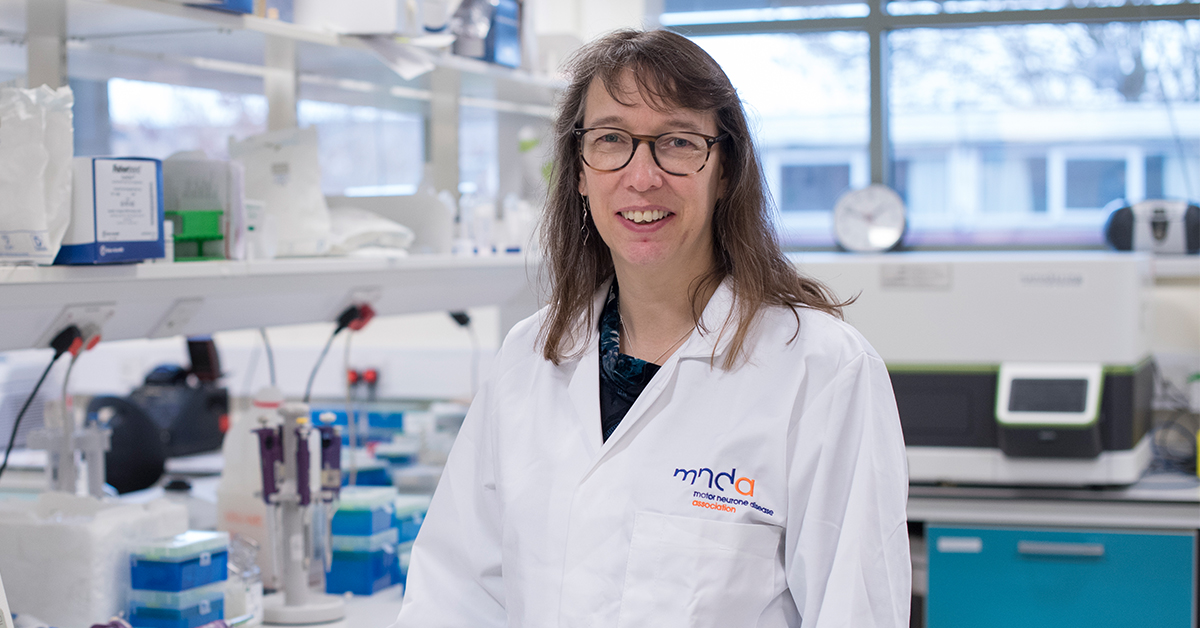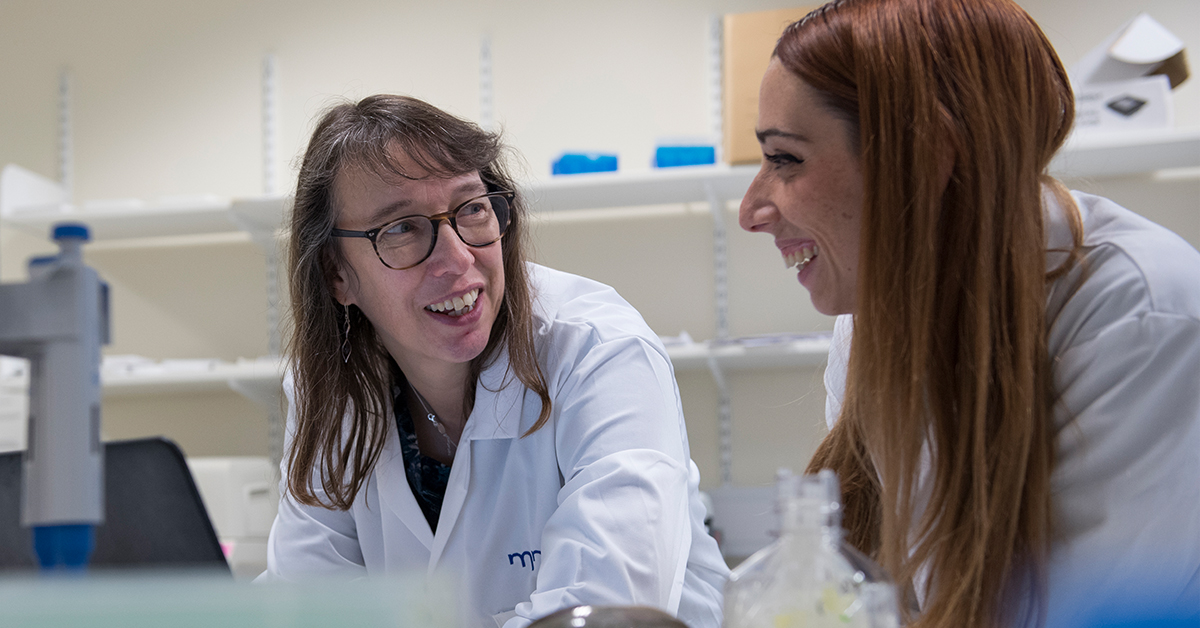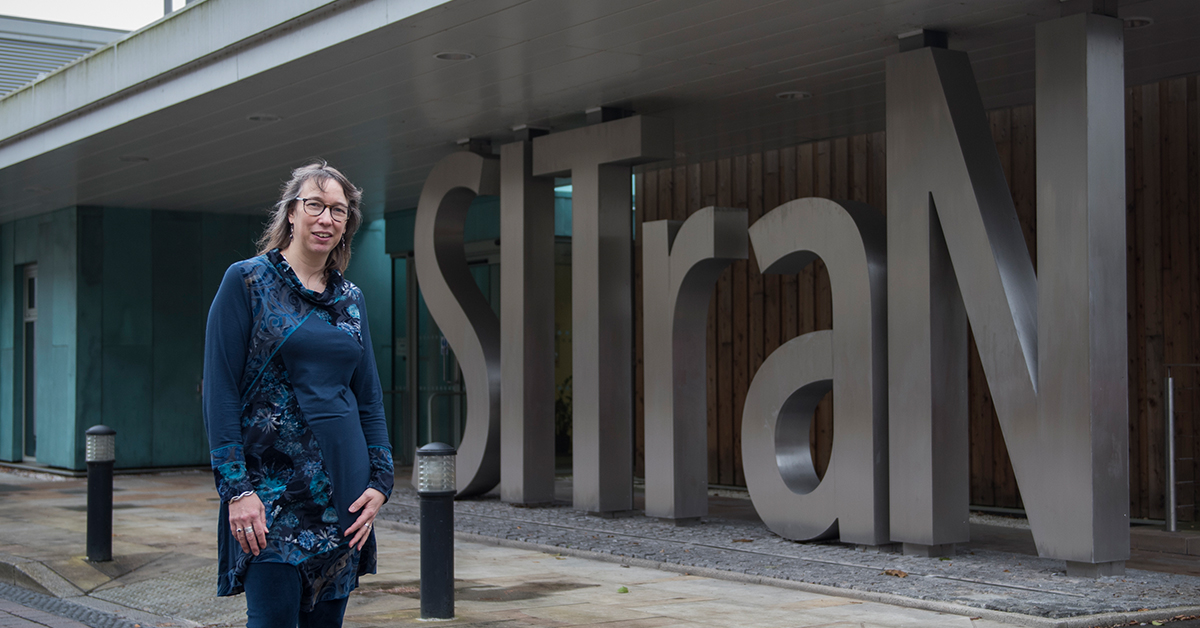Based at the SITraN lab in Sheffield, Professor Janine Kirby’s been an MND specialist for over two decades. She’s currently working on two important projects: the MIROCALS clinical trial and the AMBRoSIA biomarker project.
“I think we’re moving away from the approach of looking for a one-size-fits-all treatment,” she reveals, “and moving towards more specific treatments, based on factors like genetics.’
Biography
I grew up near Bushey, in Hertfordshire – my family still live there. I loved biology at school and went to study Zoology and Genetics at the University of Sheffield. Genetics was the thing that really interested me, though. It just seemed to click so I dropped the Zoology elements and focused on the genetics.
I was fascinated by the way genetics causes human diseases, so when it came to my PhD I chose to specialise in human genetics. At the time, the human genome mapping project was getting underway and more data about human genomes were becoming available.
An early breakthrough
After my PhD, I knew I wanted to focus on the biomedical side, looking at how genetics were associated with disease. I moved up to Newcastle to start working with Professor Pam Shaw, screening for mutations in the SOD1 gene and looking to understand exactly how they caused MND.
I followed Pam down to Sheffield in 2001. We were trying to identify genes that were differentially regulated – switched on or off. It was tough at first, but technology moved on and let us look at far more genes, initially using cell models.

Professor Kirby in the lab in Sheffield.
While I was there, we identified the NRF2 protein as being abnormal in neurons with the SOD1 mutation. We proved that it was a factor in familial MND cases, and a group in Germany has since found it’s a factor in sporadic cases.
That’s led to NRF2 being touted as a potential treatment. It’s still one of my career highlights to have identified the dysregulation in the first place.
Finding focus
These days, I’m working on two important projects here at SITraN.

Professor Kirby with her team in the lab.
The first is a clinical trial called MIROCALS, a project based in the UK and in France. We’re testing whether a molecule that occurs naturally in our bodies called interleukin-2 (IL-2) is a potential new therapy for MND.
The MND Association is funding the UK part of the trial. I’m looking at patients’ blood samples at specific times in their treatment to look for changes that are happening in response to treatment. That’s so important: it means we can understand the effect drugs are having on people and whether the drug is working on all patients, or just some of them.
I’m also working on part of a project called AMBRoSIA – a major biomarker project that the MND Association is funding. We’re sequencing 42 MND related genes so that we can understand the unique fingerprints of the disease and characterise patients and biosamples genetically by the type of gene mutation they may be carrying.
No two days are the same. I split my time between research and teaching so there’s an element of preparing lectures, lecturing students and doing tutorials, as well as writing and reviewing papers and grants. I’ll check in with my students to see how they’re getting on – sometimes one to one; sometimes sharing thoughts and ideas at larger lab meetings.

Professor Kirby has been part of the team in Sheffield for almost 20 years, since 2001.
I also make sure that we interact with patients as much as possible. We hold an open day once a year at SITraN, and I’ll go out to local branch meetings and regional conferences as well. I think it’s important that researchers understand the disease – we’re working with people, not just numbers on tubes.
It’s also important that patients feel involved in the research we’re doing – without them, so much of our work simply wouldn’t be possible.
Looking to the future
There’s so much interesting work taking place at the moment.
I think we’re moving away from one-size-fits all drugs – and moving towards more specific treatments, based on factors like genetics.
Beyond my specialism, there are promising trials for the SOD1 and C9orf72 gene mutations that cause MND, and if MIROCALS works, that could present a much broader treatment option.
And here in Sheffield, one of my PhD students is also looking into the incidence of MND in Bangladesh. The genetics of many countries in Africa and Asia is still underexplored, but it could be incredibly important in helping to develop personalised medicines for these countries in years to come.
Collaboration is key
My relationship with the MND Association began in 1996 when I attended my first International Symposium – and annual event organised by the MND Association to bring together MND researchers from around the globe.
From there on in, we’ve applied for grants, I’ve spoken at conferences, I’ve been on the Biomedical Research Advisory Panel – the panel of people from the researcher team, researchers and trustees who review applications and decide which grants get funding. I’ve seen the impact the organisation has, and how important the contribution of supporters like you is.

The Sheffield Institute for Translational Neuroscience was established in 2010 as a world class research institute.
We understand so much more about this disease than we did when I first started out. And with your support, we can finish the job – and find a cure. From the bottom of my heart, thank you for everything.

